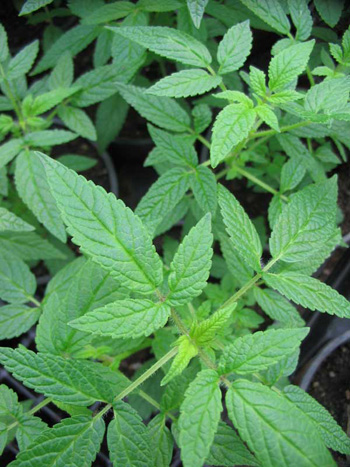Contents:
Common Names | Parts Usually Used | Plant(s) & Culture | Where Found | Medicinal Properties
Legends, Myths and Stories | Uses | Warning | Bibliography
Scientific Names

- Populus balsamifera L.
- Willow family
Common Names
- Balsam poplar
- Tacamahac
Parts Usually Used
Leaf buds, root, bark
Back to Top
Description of Plant(s) and
Culture
Populus balsamifera L.: Grows 30-100 feet. Large deciduous tree with winter buds that are large resinous and aromatic; yellowish, gummy, strongly fragrant, end buds more than 1/2 inch long. Young twigs are sparsely hairy. The alternate, broadly ovate to deltoid leaves are dark green on top and whitish underneath, sometimes hairy on the lower veins; leafstalks mostly rounded (rather than flat). The male and female flowers occur on separate, scaly catkins.
There are several trees and shrubs that have been called “Balm of Gilead”:
Quaking aspen (P. tremuloides), the black poplar (P. nigra); P. fremontii; has a slightly bitter mucilage bark similar to slippery elm bark.
Commiphora opobalsamum L. is a small evergreen tree of the bursera family native to Asia and Africa.
Populus candicans L. The common names are similar to P. balsamifera: balsam poplar, American balm of Gilead, balm of Gilead buds, Mecca balsam. This balm of Gilead has a wonderful fragrance. When boiled in olive oil, cocoa fat, or some other good oil, they make an excellent salve. Similar medicinal results with P. candicans as with P. balsamifera.
Back to Top
Where Found
Moist soils. Found on streambanks and planted along roadsides in the eastern United States, over much of Canada, and into Alaska.
Back to Top
Medicinal Properties
Balsamic, expectorant, stimulant.
Back to Top
Legends, Myths and Stories
The balm of Gilead mentioned in the Bible (Genesis 37:25 and Jeremiah 8:22) is a different plant, Comminphora meccanensis.
For wrinkles: Take barley water, strain, add a few drops of oil of balm of Gilead. Place in a bottle and let stand for 10-12 hours, shaking the bottle occasionally until the balsam is entirely mixed with the water. This mixture improves the complexion and preserves the appearance of youth. If used only once a day, it removes wrinkles and gives the skin a surprising luster. Wash the face before using this fluid.
Back to Top
Uses
Buds boiled to separate resin, then dissolved in alcohol, once used as preservative in ointments. Folk remedy (balm) used for sores; tincture for toothaches, rheumatism, diarrhea, wounds; tea used as a wash for inflammation, frostbite, sprains, and muscle strain. Internally, tea is used for cough, lung ailments, expectorant. Inner bark tea is used for scurvy, also as an eye wash, blood tonic. Root tea is used as a wash for headaches. Probably contains salicin, explaining its aspirin-like qualities.
Buds can also be made into an inhalant to relieve congestion in the respiratory passages. Their salicin content make them useful for the minor pains and aches that aspirin generally relieves.
Back to Top
Warning
Balm of Gilead is a confusing name. It has been freely applied to trees of the balsam family, trees of the willow family, trees of the poplar family and to at least one shrub found during research on this herb. Care should be taken when a formula or a recipe for treatment is given with an ingredient called “balm of Gilead” in the ingredients. Perhaps they are all similar in the biochemical makeup. Research further, that is what is recommended here if you have doubts as to which is being referred to in the recipe.
Back to Top
Bibliography
![]() Back to Eden
Back to Eden, by Jethro Kloss; Back to Eden Publishing Co., Loma Linda, CA 92354, Original copyright 1939, revised edition 1994
![]() The Herb Book
The Herb Book, by John Lust, Bantam Books, 666 Fifth Avenue, New York, NY. copyright 1974.
![]() Indian Herbalogy of North America
Indian Herbalogy of North America, by Alma R. Hutchens, Shambala Publications, Inc., Horticultural Hall, 300 Massachusetts Avenue, Boston, Massachusetts 02115, 1973
![]() The Herbalist Almanac
The Herbalist Almanac, by Clarence Meyer, Meyerbooks, publisher, PO Box 427, Glenwood, Illinois 60425, copyright 1988, fifth printing, 1994
![]() Eastern/Central Medicinal Plants
Eastern/Central Medicinal Plants, by Steven Foster and James A. Duke., Houghton Mifflin Company, 215 Park Avenue South, New York, NY 10000
![]() Planetary Herbology
Planetary Herbology, by Michael Tierra, C.A., N.D., O.M.D., Lotus Press, PO Box 325, Twin Lakes. WI 53181., Copyright 1988, published 1992
![]() American Folk Medicine
American Folk Medicine, by Clarence Meyer, Meyerbooks, publisher, PO Box 427, Glenwood, Illinois 60425, 1973
![]() Webster’s New World Dictionary
Webster’s New World Dictionary, Third College Edition, Victoria Neufeldt, Editor in Chief, New World Dictionaries: A Division of Simon & Schuster, Inc., 15 Columbus Circle, New York, NY 10023
 The Rodale Herb Book: How to Use, Grow, and Buy Nature’s Miracle Plants (An Organic gardening and farming book)
The Rodale Herb Book: How to Use, Grow, and Buy Nature’s Miracle Plants (An Organic gardening and farming book), edited by William H. Hylton, Rodale Press, Inc. Emmaus, PA, 18049., 1974
